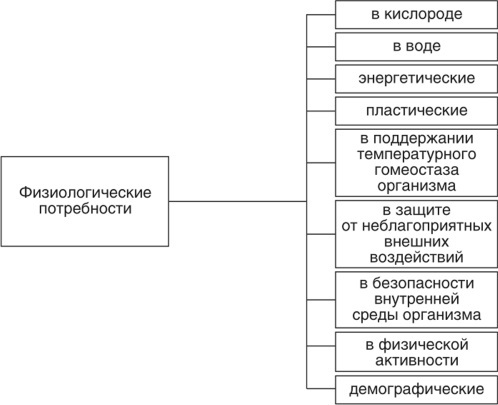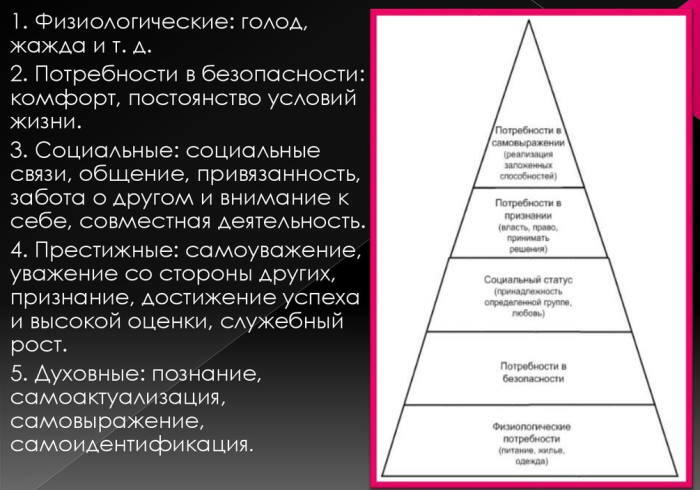Content
- The theory of occurrence and description of the Maslow pyramid
- The importance of the theory of needs for the individual
- Advantages and disadvantages
- Hierarchy of needs
- Physiological needs
- The need for security
- The need for love, friendship, belonging
- Need for recognition, respect
- The need for self-realization
- Primary and secondary needs
- Application of Maslow's pyramid in the spheres of life
- Examples of the use of Maslow's pyramid in everyday life
- Maslow's pyramid in work and business
- Disputed sides of the pyramid
- Maslow Pyramid Video
Maslow's pyramid of needs Is a psychological system of human development that describes 5 levels of harmonious satisfaction of needs: both biological and intellectual.
The theory of occurrence and description of the Maslow pyramid
Abraham Maslow was one of the most famous psychologists who, together with Karl Rogers, created a new direction in the study and development of man - humanistic psychology. The main reasons for this new view of the study of man were two aspects. First of all, Maslow and other psychologists denied the adequacy of the prevailing approach on the one hand. behaviorists who argue that psychology should only study human reactions to external irritants.
On the other hand, they wanted to get out of the psychoanalysis paradigm and focus not only on the treatment of noticeable mental disorders, but to focus on personality, who did not have cardinal deviations in the psyche, but who, like many, needed an understandable direction for its own development and the formation of a full-fledged personality.
Abraham Maslow, after many years of observing human development and self-realization, formed the idea that people are driven by certain needs at a certain level of development. Therefore, he substantiated the basic understanding of the optimal path of human development, from its most natural needs (safety and food) to higher needs, such as creativity and personal contribution to the existence of society.
Maslow's pyramid of needs, 5 levels of which describe the natural and inherent in all people needs, is an integral system of reasons and motives of the individual's desire to self-realization.
According to this model, higher needs become relevant only after basic levels are satisfied. A person is guided by the need for self-actualization and satisfaction of not only biological needs, but also social and creative ones. "Complete humanity", that is, the boundary goal of Maslow's theory, consists of a mentally healthy person and his implementation in work.
This model of rationale for human development not only made Maslow the most famous humanistic psychologist in 1950s, but also largely contributed to the revision of public understanding of human productivity activities.
The importance of the theory of needs for the individual
The significance of the theory of understanding human needs has become an absolutely new perspective for the development of personality. Prior to that, psychology as a science had never set itself the goal of studying and describing the optimal life development of a person as a person. That is why, despite its shortcomings, the theory of a personal approach to human development, proposed by A. Maslow, together with the theory of Carl Rogers, is the most popular in modern humanistic psychology.

The main idea of these approaches is the rejection of internal determinism as the main factor of development, and the transposition of this functions not to an internal unconscious reaction of a person to circumstances, but to his own conscious choice person.
According to Maslow's model of self-actualization, this process of development and improvement is for the most part an innate human property, but develops spontaneously, revealing his own potential throughout a person's life and forming the integrity of the personality, which ends at about 40 years.
The meaning of needs theory is central to every personality, which is described as striving for self-actualization, that is, full development and identification of a person's personal capabilities. According to the theory of humanitarian psychology, all people strive forward, trying to realize their potential as the main sign of human mental health.
According to Maslow's understanding, the available knowledge about human reactions and actions is not enough, because it is only a reaction to external stimuli. Therefore, in his opinion, a more valuable and significant factor in the development of personality is not an external stimulus, but an internal potential that everyone has. a person, his creative and unique abilities that a person can reveal if he can understand what exactly he wants, and not what was imposed on him society.
Advantages and disadvantages
Maslow's pyramid, describing which needs are more important to satisfy earlier, and which later, in the 1950s, was revolutionary. Observations, presented in it, largely contributed to the development of a new direction of psychology, and also changed the attitude towards the organization of work, and the understanding of what an integral personality as a whole is. But on the other hand, Maslow's pyramid has its drawbacks, because of which it is difficult to call it a truly universal model of human development.
Today, the most significant advantages and disadvantages of Maslow's pyramid are such aspects of this theory as:
| Benefits of Maslow's pyramid |
|
| Disadvantages of Maslow's pyramid |
|

The practical side of Maslow's theory of needs is not universal, it has its pros and cons, but it helps in many ways to plan the development of personality and determine how to act.
Hierarchy of needs
The hierarchy of needs of Maslow's pyramid is the main elements of the theory of the development of an integral personality. It represents 5 levels of needs, lower and higher, the satisfaction of which contributes harmonious and linear development of a person's creative potential, regardless of external circumstances.
Need is an impulse that drives a person's actions: he looks for food when he is hungry, warmth if he freezes, draws pictures when he wants to show his vision of the world.
Maslow's pyramid of needs, 5 levels of which describe how to harmoniously develop a person, first satisfying dominant needs, and move to higher ones. According to this theory, the needs of life form the basis of this pyramid, and they are inherent in all people, while the development of the next levels, although it is characteristic of everyone, but not everyone is motivated for this enough.
The main transition from one level to the second is peak experiences - they are described as bright moments of realizing the meaning of one's own actions and one's own places in society, because of which a person feels the need to move on, from the physiological needs of the first stage to the creative self-actualization of the fifth stages.
Physiological needs
Physiological needs, such as food, sleep, thirst, sexual desire, form the first stage of satisfying human needs. They are biologically necessary for human existence.
Without satisfying the need for sleep or thirst, a person cannot adequately work or be a tolerant member of society. Failure to satisfy the need for food leads to a person's aggressiveness, to a violation of social order, or to the emergence of chaos, if people are deprived of any physiological need.
Only a person who has satisfied his needs can productively and for a long time be distracted from biological impulse, and therefore with this begins the transition of his needs to another level - the need for security.
The need for security
The need for security is the second rung of Maslow's pyramid. Full safety is when a person is inherent in the purification of security in all spheres of life (career, family, personal relationships, having your own home), or understanding how this security can be restore.
The need for security implies a place or environment where a person can take refuge and take a break from the hustle and bustle of life. It is assumed that the second stage of the pyramid helps a person get rid of the fear inherent in childhood.
The need for love, friendship, belonging
From the need to feel safe, for example, follows the need not only to have family and friends, but for these relationships to be full of mutual understanding, love and support. Therefore, satisfying needs such as a sense of belonging, love and friendship is the task of the third rung of Maslow's hierarchy.
It is the third stage of needs that is the basis for the formation of a harmonious society, work collective or any harmonious relationship between people. To establish itself in the eyes of dear people for a mentally healthy person usually means that it is necessary to present something in return, to be independent and complete, and not just to expect infantile love with someone's side. It is on such conditions of mutual sympathy and readiness to support and lay the foundation for strong cells of society.
Need for recognition, respect
The need for recognition is the fourth step in Maslow's developmental hierarchy. At this stage, the formation of self-esteem of the individual takes place, which is associated with the search for respect in his own environment, receiving a vocation among colleagues and relatives.
In the opposite case, if a person receives neither recognition nor respect, he often stops in career development, the family disintegrates, and the person himself does not have any desires and aspirations, except to satisfy the needs of the three lower levels.
The need for self-realization
The need for self-realization and the search for one's own vocation is the final stage of Maslow's pyramid. It manifests itself in the need to know a certain area of interest to a person, in the manifestation of his own creativity and benefit to society.  According to Maslow's theory, at this stage, a confident and full-fledged person is guided not by fear and need, but by an interest in life, travel, and discovering one's own potential and opportunities.
According to Maslow's theory, at this stage, a confident and full-fledged person is guided not by fear and need, but by an interest in life, travel, and discovering one's own potential and opportunities.
Primary and secondary needs
Sometimes in the psychology of motivation, the concept of primary and secondary needs of Maslow's pyramid is also used, which represent a generalized distribution of 5 steps. By primary needs we mean 1 and 2 stages, which relate to the satisfaction of life support and safety. Therefore, the category of secondary needs includes 3-5 steps, which relate to the social role of a person, his prestige in society and the level of spirituality.
Application of Maslow's pyramid in the spheres of life
Maslow's pyramid of needs, 5 levels of human needs, described in her theory, allows you to apply this knowledge in all areas of life. This hierarchy simply explains what a person may lack in life, what aspects of his activities are not balanced, how to find the cause of misunderstanding with others: in the family, in a career or in circle of friends.
Therefore, understanding the principles described in Maslow's pyramid will allow not only to plan one's own harmonious development, but also to understand because of what there are misunderstandings with other people, where the interests of the parties do not intersect and what is the best way to find a compromise in acceptance solutions.
Therefore, it can be used for the diagnosis and development of all spheres of life, and not just one.
The principles of self-actualization conditions, according to Maslow's pyramid, are quite simple, and more like philosophical guidelines rather than strict rules:
- the ability to dissolve in life experience, implying full involvement in the process of learning, work, or even cleaning;
- to perceive life as a multitude of choices, the willingness to make decisions on their own, remember about their own responsibility;
- the ability to listen to yourself, your own needs and desires;
- be honest with yourself and everyone, the ability to say "no";
- desire to work in full force, strive to be better than before;
- the desire to identify their own psychological clamps, or defense mechanisms, and their elimination;
- the ability to see the good.

Maslow's pyramid allows you to form a healthy, full-fledged personality, capable of resolving conflicts and showing their own abilities.
Examples of the use of Maslow's pyramid in everyday life
Maslow's pyramid of needs, 5 levels of which are designed to form a deliberate and harmonious life approach and realization of the individual's own potential, can be used not only in career development, but also in everyday life life.
Maslow's pyramid was not designed to compensate for weaknesses or insecurities for the sake of any one goal, such as career advancement. Its main message was that everyone can live their daily life in a balanced way without prejudice to any area of activity. That is, according to Maslow's pyramid, a person should strive for great goals, and at the same time not lose his head, and not forget about other aspects of life.
Self-actualizing people, that is, those who have reached the highest levels of the pyramid, actually have all the balanced sides of life, and not just one. Living just for the sake of wealth is an idea outside the Maslow pyramid, and this is the path to a miserable life, because such a lifestyle rarely allows you to show your own capabilities.
According to Maslow, the values of being are more than filling life with beauty and order, they are what each person strives for in his own way in the process of self-actualization. If the needs of one level are satisfied (for example, security), then the meta-needs of the next level are awakened in the person.
Thus, each person reveals in himself the presence of not only physiological and biological needs, but also spiritual and intellectual ones, which fill his life with meaning. On the other hand, due to psychological problems (“diseases of the soul”), many people cannot formulate their own needs, which are the meaning of life to satisfy.
Maslow's pyramid in work and business
The main idea of humanistic psychology, and Maslow's pyramid, in particular, is to ensure the natural development of a person's potential, the disclosure of his talents and capabilities. These promises and the obvious results of observations at one time drew the attention of the business environment to the opportunities that the correct use of Maslow's pyramid can offer.
Thus, in order to improve the performance and organization of employees in order to realize their creative potential, Maslow's pyramid ideas have been adapted several times in the work environment. The main advantage of using Maslow's pyramid in business is to intelligently meet the needs of employees through the prism of increasing their productivity and effectiveness.
Maslow himself adapted the ideas of the pyramid for the business environment, describing it with the concept
"Eupsichea" - that is, the creation of a culture by self-actualizing individuals in which there is a high level of responsibility and dedication, in whose work and creativity no one intervenes. Whole individuals who have achieved self-actualization are devoid of conventions and various reasons for disagreement. They are able to find compromises and eliminate hierarchical structure in the organizational environment.
The methods of managing such an environment were aimed at maintaining the psychological health of employees and meeting their needs. It is in such conditions, according to Maslow, that creativity, as a long process, can reveal itself as much as possible, and not be just a flash of inspiration.
Maslow's pyramid of needs and its 5 levels on the other hand are also actively used in the field of marketing - understanding human needs and preferences allows you to create successful products and find a response among buyers, as well as make long-term plans and forecasts of the relevance of any services.
Disputed sides of the pyramid
The practical foundation of Maslow's theory consists of rationalizing how best to develop and satisfy one's own needs.
With the correct achievement of the desired, a person is able to experience strong motivation and the desire to achieve the goal, regardless of unexpected obstacles. That is why Maslow's theory of needs is widely used in modern educational systems - it allows you to draw up an adequate training plan in accordance with the motives of a person's personal growth.
But on the other hand, Maslow's model is not universal. It is built on the observation of a person with an ideal psycho-emotional and social background of existence.
Therefore, in real life, where people do not always have a harmonious experience of personal development, with an unstable psycho-emotional background and different levels of confidence, the pyramid Maslow may not take into account the many underwater aspects of behavior and not take into account the specific nuances inherent in modern professional and personal development.
According to Maslow's theory, all people have the potential for self-actualization, but because of the Jonah complex, few succeed in reaching higher stages of development. The essence of this complex is the fear of one's own greatness, an attempt to avoid calling, and it is also the fear of losing control. According to Maslow's observations, people are equally afraid of their bad sides as well as their good ones.
Therefore, for maximum results, it is necessary to supplement Maslow's pyramid with other theories for analyzing the character and personal experience of each person.
Maslow's pyramid of needs and ideas has its own inaccuracies and a certain shade of utopianism. But 5 levels of human development more than other concepts inspired humanistic psychologists to develop the psychology of a healthy person.
Maslow Pyramid Video
Maslow's pyramid of needs:



